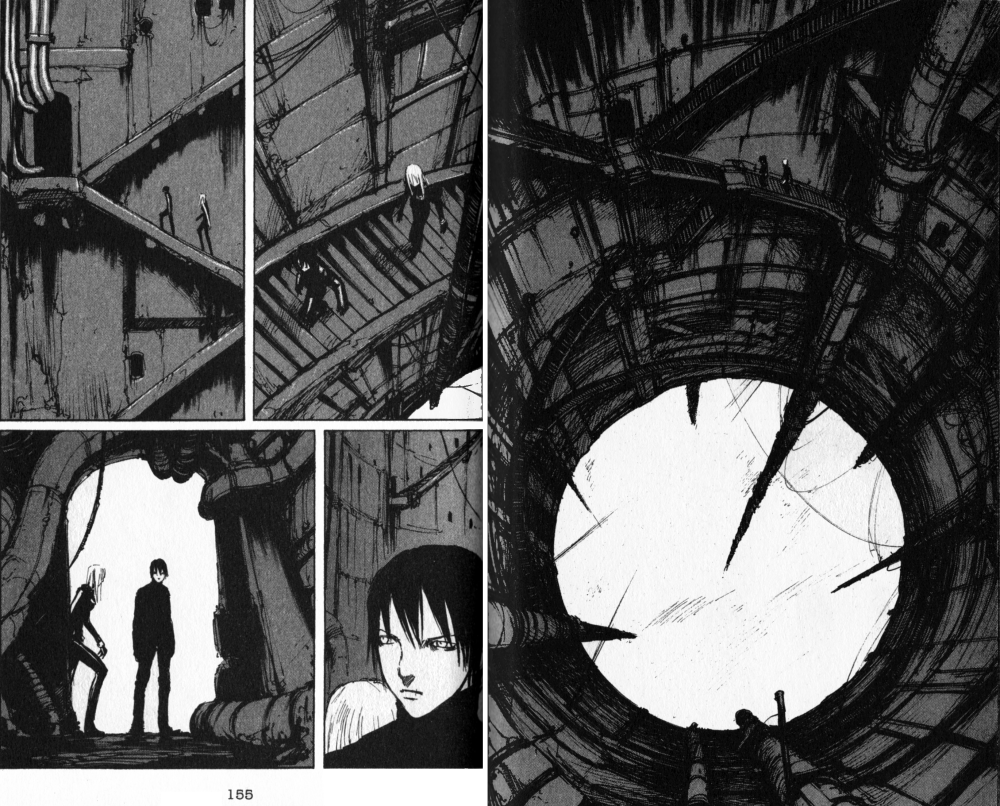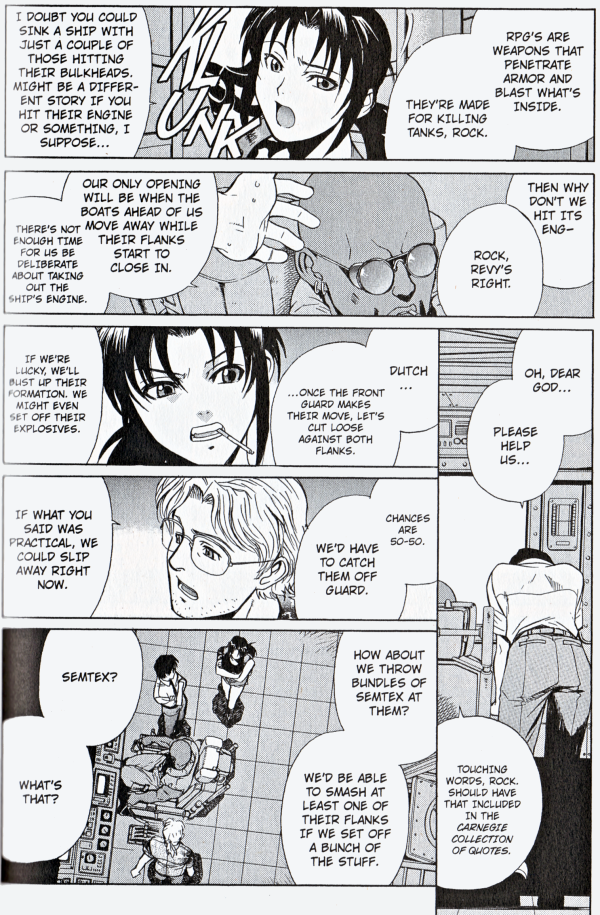MICHELLE: After a few months of this column, I feel like I’m better able to think critically about the artistic aspect of manga. I expected to be able to better appreciate good art when I see it, but hadn’t anticipated that I’d also more readily notice flaws. This month, MJ (of Manga Bookshelf) and I turn our attention to problematic pages or, as I like to call them, “duds.” (Click on images to enlarge.)
Fairy Tail, Volume 10, Page 84 (Del Rey)

MJ: Wow. I’m… a little bit stymied by that image.
MICHELLE: It is a doozy, isn’t it? Actually, that page was the inspiration for this whole column. There I was, innocently reading volume ten of Fairy Tail, then I turned the page and was brutally accosted by that monstrosity!
So, as is probably pretty obvious, the speaker is unhinged. Mangaka Hiro Mashima has opted to depict this by freezing the guy in the act of making a weird face and forcing readers to read two huge bubbles full of ranting speech before we can proceed to the final (and uninteresting) panel on the bottom of the page. Now, maybe this is a tactic to make us feel as trapped as the girl does, having to sit there and listen to this lunatic ramble on, but it doesn’t do a good job at conveying his insanity. The page feels flat and lifeless; a better choice would have been to inject more movement into the scene, break up the speech, and maybe allow the guy the opportunity to change expressions throughout his tirade.
MJ: I honestly feel accosted by the page. Its primary image is loud, but not particularly expressive in any other way than that, and the text feels overwhelming to the point where I can’t really even bring myself to try to read it all. Not only that, the page is so top-heavy, I find it difficult to even look at. That bottom image is completely wasted there, not that it’s much of a waste.
MICHELLE: Yeah, it’s weird how an amount of text that would be perfectly reasonable to read in a prose novel suddenly looks so daunting in a speech bubble, but it really does. And you’re absolutely right that it’s loud without being expressive. Everything about this page is just so glaringly bad that I knew we had to build a column around lousy art so that I’d have an excuse to talk about it with someone!
MJ: Well, feel free to talk as much as you like, because I’ve rarely seen something so pointlessly hideous. And though I hate to think that I’m reacting purely out of aesthetics, I can’t deny that it offends me greatly on that level.
MICHELLE: I think that’s pretty much the only basis on which you can be expected to react, since you haven’t read the manga in question. For me, it completely yanked me out of the story, which I find inexcusable.
And though I appreciate the offer to further vent my spleen, perhaps we should proceed on to your dud of choice.
Baseball Heaven, pages 133-134 (approx.) (BLU Manga)

MJ: Okay, then. My “dud” comes from Ellie Mamahara’s Baseball Heaven, a BL manga I expressed no great love for in our BL Bookrack column a couple of months ago. I assume I don’t need to describe what’s happening in the scene, and chances are I don’t need to tell anyone what’s wrong with it, either, but of course that’s why we’re here.
I look at this scene, and there’s simply no passion in it. None at all. Here we have a guy, supposedly in an altered state of mind, making the moves on his teammate who has rebuffed him in the past, and not only do we not get any real sense of how either of them are feeling (we wouldn’t even know the one was drunk if it wasn’t for indications in the word balloons and flushed cheeks), but there’s absolutely no sexual tension between them conveyed through the artwork. And while I can appreciate that perhaps we’re meant to believe that athletes might be stiff and awkward with each other, surely the drunk guy, at least, would have a little heat in his body language here.
The artist goes through the motions, placing them physically near each other and indicating that the one is, perhaps, touching the other’s behind, but there is just no real feeling between them at all. Even when their faces are so close together, Mamahara is unable to provide any magnetic reaction between them. I should feel that they *want* to touch each other. It should feel painful for them not to. Instead, it leaves me completely cold.
MICHELLE: I definitely see what you mean! Personally, I keep staring at that first panel on the second page. They look so stiff and awkward. It’s not that I expect the position of a character’s legs to help drive the emotional content of a scene, but when they’re as oddly placed as the blond guy’s are, it feels unnatural and, by extension, makes everything else going on in the scene feel the same way.
MJ: I think I’d go so far as to say that in a scene like *this* one, I kind of *do* expect the position of a character’s legs to help drive the emotional content of the scene. It’s just as I was saying before, there should be a sense that the characters want desperately to touch each other (this includes legs) even if they might be scared to do so. I should see that in the legs and every other part of the body, at least in the drunk guy who is initiating the contact in the first place. It’s a seduction scene with no actual seduction going on.
Also, I feel like the panels are getting in the way of us viewing the scene, which is a weird and uncomfortable feeling. And unlike in last month’s selection where this was done to elicit response from the reader, here it just feels like clumsiness on the part of the artist. She provides these little glimpses of their faces and legs in the smaller panels, but since there is no tension in those panels, they don’t add anything to the scene. They just steal space from the main action, such as it is.
Wow, I’m really ranting now, aren’t I? Please stop me.
MICHELLE: You’re quite right, but I shall stop you as requested by introducing my second dud!
Moon Boy, Volume 9, Page 3 (Yen Press)

MICHELLE: Initially, it was the affronted rooster in the lower left that caught my eye and made me pause to really take in the complete and utter randomness of this page.
You’ve got a young person of indeterminate gender, swaddled in coat and boots, flushed and exhaling a gust of wintry air, possibly due to the exertion of just having decapitated a nearby snowman. This person is surrounded by such seasonal items as a piece of pie, a cookie, a beehive (with fake bees), an inverted dog bowl, and a pair of barnyard pals.
This was enough to have me snickering, but closer inspection reveals several problems in proportion and perspective. For one, take a look at that snowman’s nose. I’m pretty sure that is supposed to be the traditional carrot, but the artist was unable to draw it from a head-on perspective so instead it looks like a giant almond. Secondly, check out the boots. The right foot is clearly much larger than the left, and I don’t think it’s just an issue of angle—the detail on the top of each foot is different! Finally, actually wearing the mitten dangling by the person’s right hand on said hand would cause the heart pattern to appear on the palm side rather the back of the hand, where such designs typically go.
This is just sloppy and, above all, weird. What do these items have to do with each other? I also found it odd that one of the designs in the border is actually a musical symbol called a mordent. The mordent belongs to a class of musical embellishments called “ornaments,” which could carry a Christmassy connotation, except that I don’t credit this artist with that much cleverness.
MJ: I’ll admit I’m not too picky about things like perspective and such, but I am somehow disturbed by the way his fingers are digging into the poor snowman’s head. What did that poor (decapitated) snowman ever do to anyone? It’s as though he’s digging right into its scalp. Which looks oddly fleshy. And now I’m feeling shuddery.
MICHELLE: I don’t think I would have noticed the perspective problems if not for the chicken, to be honest, but spotting it here did spur me to notice other problems in the rest of the volume, notably a few deformed thumbs and some confusing action scenes that I wrote about in my review of the volume. I wasn’t sure what to make of the hands, honestly. If it’s that cold, why aren’t you wearing your mittens, kid?
MJ: If he put on his mittens, he wouldn’t be able to grab that piece of pie when it comes down. 😉
MICHELLE: Well, pie is important…
And that’s it for us this month. Do you have some duds of your own you’d like to share? We’d love to hear about them!






















Recent Comments